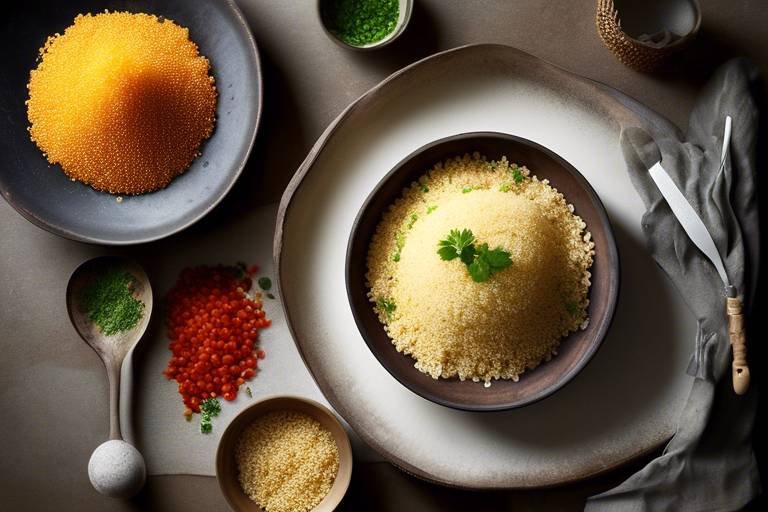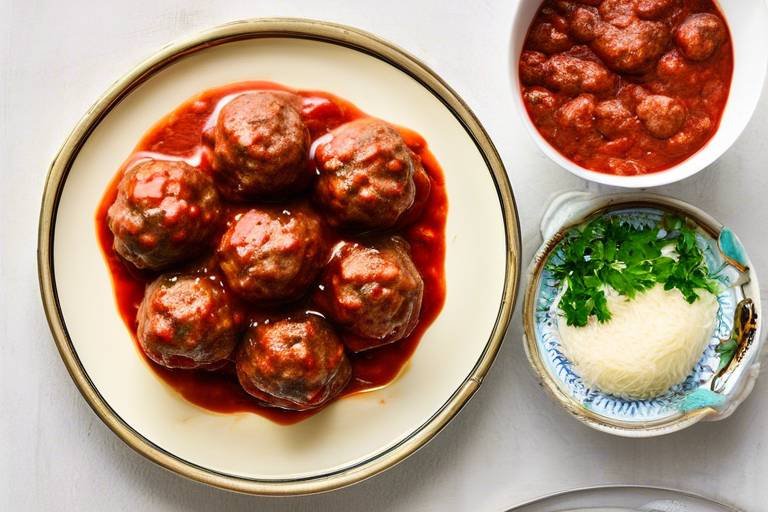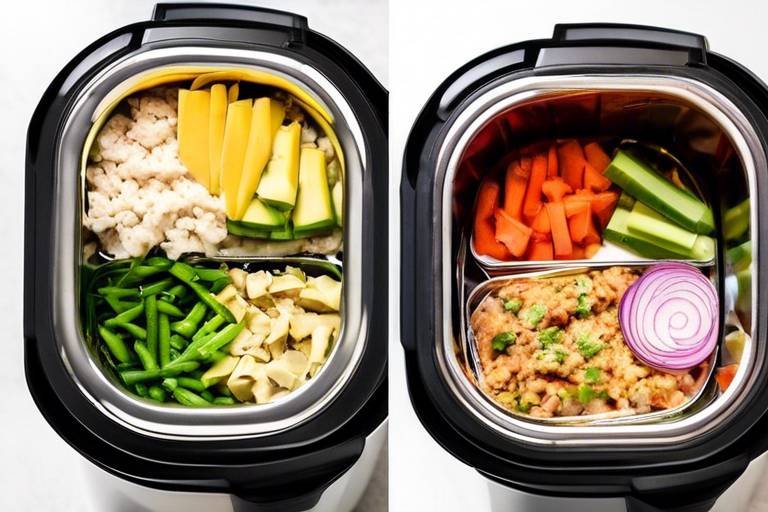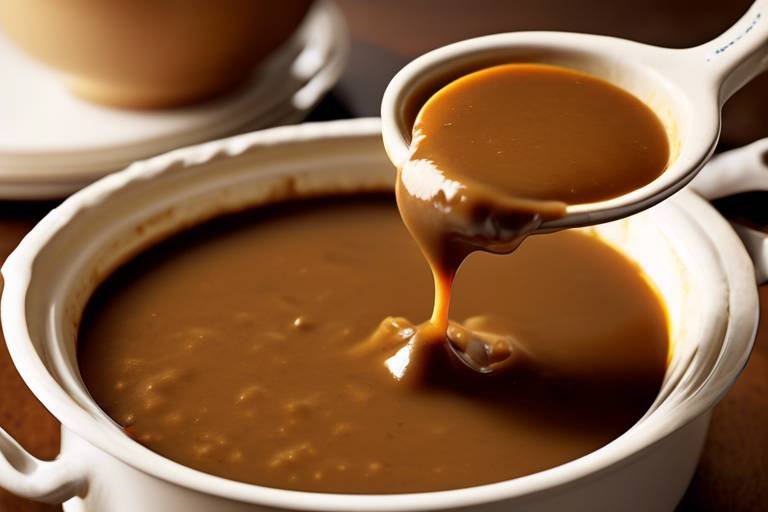How to Cook the Perfect Risotto - A Step-by-Step Guide
Master the art of making a creamy and flavorful risotto with this detailed step-by-step guide. From selecting the right rice to adding the final garnish, every aspect of cooking the perfect risotto is covered.
Choosing the Right Rice: When embarking on the journey of making the perfect risotto, the first crucial step is selecting the right rice. Arborio, Carnaroli, or Vialone Nano are popular choices due to their high starch content, which is essential for achieving that creamy texture risotto is known for. These varieties absorb liquid well, releasing starch as they cook, creating the desired creaminess.
Sautéing the Aromatics: The foundation of a delicious risotto lies in the aromatic base. Sautéing onions, garlic, and other aromatics in butter or olive oil until they are translucent and fragrant is key to building layers of flavor. This step sets the stage for a rich and savory dish.
Adding the Broth: As you embark on the cooking process, gradually adding warm broth to the rice is essential. The slow addition of broth, one ladle at a time, allows the rice to release its starches slowly, resulting in a creamy texture. Stirring continuously helps to coax out the starch and create that luscious consistency.
Mastering the Cooking Technique: Achieving the perfect risotto consistency requires patience and precision. Maintaining a gentle simmer and stirring constantly are crucial elements in coaxing the starches from the rice and creating a creamy texture. The rice should be cooked until it is al dente, with a slight bite to it.
Enhancing with Wine and Cheese: Elevate the flavor of your risotto by incorporating wine and cheese. Adding a splash of wine early in the cooking process infuses the dish with depth and complexity. Parmesan or Grana Padano cheese stirred in at the end adds a luxurious creaminess and a salty kick.
Testing for Doneness: To ensure your risotto is perfectly cooked, taste and texture are key indicators. The rice should be creamy yet slightly firm to the bite, with a consistency similar to a thick porridge. Properly cooked risotto flows and settles on the plate rather than holding its shape rigidly.
Experimenting with Flavors: The beauty of risotto lies in its versatility. Feel free to experiment with various flavor combinations, such as mushroom and truffle, seafood, or butternut squash. Adding fresh herbs, spices, or proteins can personalize your risotto and cater to your taste preferences.
Presenting and Serving: The presentation of your risotto can elevate the dining experience. When plating, consider shaping the risotto into a neat mound using a ring mold or serving it family-style in a large bowl. A final sprinkle of fresh herbs, a drizzle of quality olive oil, or a shaving of cheese adds a finishing touch.

Choosing the Right Rice
Master the art of making a creamy and flavorful risotto with this detailed step-by-step guide. From selecting the right rice to adding the final garnish, every aspect of cooking the perfect risotto is covered.
When it comes to making the perfect risotto, choosing the right rice is crucial. Arborio rice is the most commonly used variety due to its high starch content, which helps create that creamy texture risotto is known for. Other suitable options include Carnaroli and Vialone Nano rice, each offering a slightly different texture and consistency. Consider the type of risotto you want to make and select the rice variety that best suits your preferences.
One of the key steps in preparing risotto is sautéing the aromatics. Onions, garlic, and sometimes shallots are typically used to build a flavorful base for the dish. Sautéing these ingredients in butter or olive oil releases their natural flavors, enhancing the overall taste of the risotto.
To achieve that creamy consistency risotto is famous for, it's essential to gradually add warm broth to the rice. This process allows the rice to release its starch slowly, resulting in a velvety texture. Stirring continuously while adding the broth helps evenly distribute the liquid and ensures the rice cooks evenly.
Cooking risotto to perfection requires patience and attention to detail. Maintaining the ideal temperature and cooking time is crucial to achieving the desired consistency. The rice should be cooked until al dente, with a slight bite to it, while still being creamy and smooth.
For an extra layer of flavor, consider incorporating wine and cheese into your risotto. Adding a splash of white wine early in the cooking process provides acidity and depth, while stirring in grated Parmesan or Pecorino cheese towards the end adds richness and creaminess to the dish.
To determine if your risotto is perfectly cooked, taste it to ensure the rice is tender yet slightly firm to the bite. The texture should be creamy, with the grains of rice distinct but not mushy. Properly cooked risotto should flow and settle slightly on the plate when served.
Don't be afraid to get creative with your risotto by experimenting with different flavor combinations and ingredients. Whether you prefer a classic mushroom risotto or a seafood variation, adding herbs, spices, and seasonal vegetables can elevate the dish and make it uniquely yours.
When it comes to serving risotto, presentation is key. Plate the risotto elegantly, using a ring mold for a neat presentation or simply spooning it onto the plate for a rustic look. Garnish with fresh herbs, a drizzle of olive oil, or additional cheese to enhance the visual appeal and overall dining experience.

Sautéing the Aromatics
Master the art of making a creamy and flavorful risotto with this detailed step-by-step guide. From selecting the right rice to adding the final garnish, every aspect of cooking the perfect risotto is covered.
Learn about the different types of rice suitable for making risotto and how to select the perfect one for your dish.
Sautéing the aromatics is a crucial step in building the foundation of flavor for your risotto. As you gently cook the onions, garlic, and other aromatics in butter or olive oil, their fragrances will fill your kitchen, setting the stage for a delicious dish. This process not only enhances the taste but also adds depth to the overall profile of the risotto.
Understand the process of gradually adding warm broth to the rice and stirring continuously to achieve the desired creamy texture.
Explore the techniques involved in cooking risotto to perfection, including the ideal temperature and cooking time.
Learn how to elevate the flavor profile of your risotto by incorporating wine and cheese at the right stages of cooking.
Find out how to determine when your risotto is perfectly cooked and ready to be served.
Get creative with different flavor combinations and ingredients to personalize your risotto and make it uniquely yours.
Discover tips on how to plate and garnish your risotto for an impressive presentation that enhances the dining experience.

Adding the Broth
Master the art of making a creamy and flavorful risotto with this detailed step-by-step guide. From selecting the right rice to adding the final garnish, every aspect of cooking the perfect risotto is covered.
Learn about the different types of rice suitable for making risotto and how to select the perfect one for your dish.
Discover the importance of sautéing onions, garlic, and other aromatics to build a flavorful base for your risotto.
When it comes to adding the broth to your risotto, it's crucial to do so gradually. This process involves pouring warm broth into the rice one ladle at a time while stirring continuously. The gradual addition of broth allows the rice to release its starch slowly, resulting in the desired creamy texture of the risotto.
Explore the techniques involved in cooking risotto to perfection, including the ideal temperature and cooking time. The key is to maintain a gentle simmer and stir consistently to ensure the rice cooks evenly and absorbs the flavors of the broth.
Learn how to elevate the flavor profile of your risotto by incorporating wine and cheese at the right stages of cooking. Wine adds depth and complexity, while cheese provides richness and creaminess to the dish.
Find out how to determine when your risotto is perfectly cooked and ready to be served. The risotto should have a creamy consistency with a slight bite to the rice grains, known as "al dente."
Get creative with different flavor combinations and ingredients to personalize your risotto and make it uniquely yours. From seasonal vegetables to seafood or mushrooms, the possibilities are endless for customizing your risotto.
Discover tips on how to plate and garnish your risotto for an impressive presentation that enhances the dining experience. Whether serving as a main course or a side dish, a beautifully presented risotto is sure to impress your guests.

Mastering the Cooking Technique
Mastering the cooking technique is crucial in achieving the perfect risotto consistency and flavor. The key lies in the process of gradually adding warm broth to the rice while stirring continuously. This method allows the rice to release its starches, creating that signature creamy texture that makes risotto so irresistible. It's like conducting a symphony, each stir harmonizing the flavors and textures to create a masterpiece on your plate.
When cooking risotto, patience is your best friend. The rice needs time to absorb the broth and develop its rich flavor. Maintaining the ideal temperature is essential to ensure that the rice cooks evenly without becoming mushy. It's a delicate balance of heat and timing, much like crafting a delicate piece of art where precision is key.
Another crucial aspect of mastering the cooking technique is knowing when the risotto is ready. The rice should be al dente, with a slight bite to it, while still being creamy and luxurious. This balance of textures is what sets a well-cooked risotto apart from the rest. It's all about timing and intuition, knowing exactly when to take it off the heat to achieve that perfect consistency.
As you hone your risotto-making skills, don't be afraid to experiment with different variations and ingredients. Whether you prefer a classic mushroom risotto or a more adventurous seafood risotto, the cooking technique remains the same. The beauty of risotto lies in its versatility, allowing you to unleash your creativity in the kitchen and create dishes that reflect your unique taste and style.

Enhancing with Wine and Cheese
Master the art of making a creamy and flavorful risotto with this detailed step-by-step guide. From selecting the right rice to adding the final garnish, every aspect of cooking the perfect risotto is covered.
Learn about the different types of rice suitable for making risotto and how to select the perfect one for your dish.
Discover the importance of sautéing onions, garlic, and other aromatics to build a flavorful base for your risotto.
Understand the process of gradually adding warm broth to the rice and stirring continuously to achieve the desired creamy texture.
Explore the techniques involved in cooking risotto to perfection, including the ideal temperature and cooking time.
When it comes to enhancing the flavor of your risotto, wine and cheese play crucial roles. The addition of wine adds depth and complexity to the dish, while cheese provides a creamy richness. It is essential to incorporate these ingredients at the right stages of cooking to achieve a well-balanced and delicious risotto.
Find out how to determine when your risotto is perfectly cooked and ready to be served.
Get creative with different flavor combinations and ingredients to personalize your risotto and make it uniquely yours.
Discover tips on how to plate and garnish your risotto for an impressive presentation that enhances the dining experience.
Stay tuned for the answers to common questions about cooking risotto.

Testing for Doneness
When it comes to cooking the perfect risotto, determining the doneness is crucial to achieving the ideal texture and flavor. One popular method to test for doneness is the taste test. Take a small spoonful of risotto and check if the rice is cooked to a creamy consistency with a slight al dente bite. The grains should be tender but not mushy, maintaining a slight firmness in the center.
Another way to test for doneness is by observing the risotto's consistency. The final texture should be creamy and smooth, with the rice grains suspended in a velvety sauce. If the risotto appears too dry, add a bit more warm broth and continue stirring until you reach the desired creaminess.
Additionally, pay attention to the overall appearance of the risotto. The dish should have a glossy sheen and a slightly loose consistency, allowing it to flow and settle on the plate elegantly. Avoid overcooking the risotto, as it can result in a sticky and stodgy consistency, diminishing the overall enjoyment of the dish.

Experimenting with Flavors
Experimenting with flavors is where the magic truly happens in the world of risotto. This is your chance to let your creativity shine and tailor your dish to suit your unique taste preferences. Imagine your risotto as a blank canvas waiting to be adorned with a symphony of flavors that will tantalize your taste buds.
One way to experiment with flavors is by incorporating different herbs and spices into your risotto. Whether you prefer the earthy aroma of rosemary, the freshness of basil, or the warmth of saffron, herbs and spices can take your risotto to new heights. Consider creating a herb-infused broth for an added layer of complexity.
Another exciting avenue for flavor experimentation is through the addition of various proteins and vegetables. From succulent shrimp to tender chicken, or from vibrant peas to earthy mushrooms, the possibilities are endless. Mix and match different ingredients to create a risotto that is as hearty or light as you desire.
Don't shy away from playing with different types of cheese to enhance the creaminess and richness of your risotto. Whether you opt for the sharpness of Parmesan, the creaminess of gorgonzola, or the nuttiness of pecorino, cheese can elevate the flavor profile of your dish to a whole new level.
Consider adding a splash of acidity to your risotto by incorporating a squeeze of lemon juice or a drizzle of balsamic reduction. The brightness of acidity can balance the richness of the dish and add a refreshing twist to each bite. Experiment with different acidic elements to find the perfect balance for your palate.
Lastly, don't forget about the power of texture in enhancing the overall experience of your risotto. Whether you sprinkle toasted nuts for crunch, crispy pancetta for a salty bite, or fresh herbs for a pop of freshness, texture can add dimension to every mouthful. Let your imagination run wild and create a risotto that is not only bursting with flavor but also a delight to the senses.

Presenting and Serving
When it comes to presenting and serving your perfectly cooked risotto, attention to detail can truly elevate the dining experience. Imagine your dish as a work of art, with each element carefully considered to delight both the eyes and the taste buds. The way you plate and garnish your risotto can make all the difference in how it is perceived and enjoyed.
Start by selecting the right serving dish that complements the colors and textures of your risotto. A wide, shallow bowl is often preferred as it allows the creamy rice to spread out evenly, creating an inviting presentation. Consider the overall aesthetic you want to achieve and choose a dish that enhances the visual appeal of your dish.
When it comes to garnishing your risotto, less is often more. A sprinkle of fresh herbs like chopped parsley or basil can add a pop of color and freshness to the dish. You can also drizzle a touch of high-quality olive oil or a sprinkle of grated Parmesan cheese on top for added flavor. Remember, garnishes should not overpower the delicate flavors of the risotto but rather complement and enhance them.
For a final touch of elegance, consider adding a decorative element to your plate. A simple garnish like a lemon twist or a sprinkle of edible flowers can add a touch of sophistication to your presentation. Remember, presentation is not just about how the dish looks but also about how it makes the diner feel. A beautifully presented risotto can evoke anticipation and excitement before the first bite.
Frequently Asked Questions
- What type of rice is best for making risotto?
The best rice for making risotto is Arborio rice, known for its high starch content that creates the creamy texture risotto is famous for.
- Can I use any other type of rice for risotto?
While Arborio rice is the traditional choice, you can also use Carnaroli or Vialone Nano rice for making risotto, as they have similar characteristics suitable for this dish.
- Why is it important to sauté the aromatics before adding the rice?
Sautéing onions, garlic, and other aromatics before adding the rice helps to develop their flavors and create a flavorful base for the risotto.
- How do I know when my risotto is done?
You can tell when risotto is done by tasting it - the rice should be creamy yet slightly al dente. It should have a smooth texture without being mushy.
- Can I make risotto ahead of time?
Risotto is best served immediately after cooking to enjoy its creamy texture. However, you can prepare it slightly ahead and reheat it gently with a little extra broth to revive the creaminess.
- What are some popular flavor combinations for risotto?
Popular flavor combinations for risotto include mushroom and truffle, asparagus and lemon, or butternut squash and sage. Feel free to experiment with different ingredients to create your own unique flavors.



















